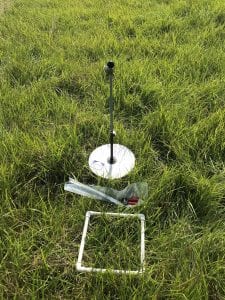Jason Johnson, Public Affairs Specialist, USDA NRCS
(Previously published online in Wallaces Farmer: April 15, 2019)
Row crop farmers are beginning to focus more on improving soil health on their land for long-term sustainability. But according to USDA soil health and grassland specialists, livestock producers can also implement soil health practices to improve their pastures.
farmers are beginning to focus more on improving soil health on their land for long-term sustainability. But according to USDA soil health and grassland specialists, livestock producers can also implement soil health practices to improve their pastures.
Many Midwest farmers are using soil conservation practices like no-till farming, cover crops and extended crop rotations to improve soil health on cropland. Similarly, livestock producers can adopt practices traditionally meant for forage improvement to feed microorganisms and add organic matter to the soil. Practices like rotational grazing, interseeding and forage harvest management help improve both forages and soil health.
Jeff Matthias, state grassland specialist for USDA’s Natural Resources Conservation Service in Iowa, says soil health and pasture health are interdependent. “Pasture health depends on the function of the soil and plant communities,” he says. “The way producers manage pastures will affect the soil’s ability to help produce desired pasture plants.”
Matthias says, for example, that a properly managed pasture with rotational grazing and adequate rest periods will lessen soil compaction compared to continuously grazed pasture. Reduced compaction will help increase water infiltration rates and the respiration of plant roots and soil organisms.
Drought-resistant pastures
A major benefit of improving soil health on pastures is building up drought resistance. Farmers should ensure their land is healthy enough to resist droughts and weed infestations, says Doug Peterson, regional soil health specialist for NRCS. “Managing pastures with soil health in mind will improve aggregate structure, which will improve infiltration,” he notes. “Increased organic matter improves the soil’s ability to store water.”
Bill Totemeier, who rotates about 180-head of mostly South Poll cattle throughout 470 acres near New London in southeast Iowa, uses mob grazing and a grass legume mixture to protect his soil and grass from extreme weather and produce healthier, more productive animals.
Mob grazing involves moving cattle (or other livestock) multiple times per week or even daily when forages are growing exponentially. Paddocks are sized based on the amount of available forage and the amount that livestock will need during the occupancy of each paddock. Portable electric fence is used to confine the cattle.
Pasture management pays off
Totemeier’s goal is for every plant in the grazing cell to be eaten or walked on and trampled during the short occupancy of the paddock. He then rests each paddock for 60 to 120 days or more. “Mob grazing is almost like drought insurance because a long resting period means a longer plant recovery and a deeper root in the plant,” he says.
Good pasture management leads to healthy soils. Besides building drought resistance, the following are ways Matthias says improvements in soil health occur from good pasture management:
- increased soil organic matter increases water available for plant growth
- improved water infiltration
- more nutrients available for plant growth
- better soil conditions for germination, seedling establishment, vegetative reproduction and root growth
- ability of the soil to act as a filter, protecting water and air quality
- increased plant production and reproduction
- reduced soil erosion from water
- carbon sequestration from air
Avoid overgrazing
Overgrazing can lead to significant long-term degradation and an overall reduction in pasture condition and yields. Peterson says overgrazing is often the reason for diminished soil properties, which allows undesirable and invader species to gain a foothold. “As forage production decreases, soil conditions continue to spiral downward, while forage requirements stay the same or even increase,” he says.
Producers sometimes allow livestock to overgraze pastures to leave no “wasted” grass, but Matthias says potential yields are never realized. “Graziers assume they are at potential when they may only be harvesting 30% of the potential yield,” he says. “I compare it to a row crop farmer who does a fantastic job harvesting corn, but only yields 75 bushels per acre due to mismanagement during the growing season when the yield potential is 240 bushels per acre using ideal management.
“If we had yield monitors on our cows, it would show we are not harvesting the potential forage from our overgrazed pastures.”
4 keys to improved grazing
To avoid overgrazing, Peterson recommends graziers follow four basic rules:
- Balance stocking rate with forage availability. Determining initial stocking rate requires collecting information on overall pasture production and balancing the animal numbers with available forage.
- Increase management control by increasing the number of paddocks. Lengths of grazing and rest periods are key factors in allowing plants adequate recovery time. Grazing periods that are too long and recovery periods that are too short are a major reason why pasture conditions deteriorate.
- Improve utilization rate. Increasing the control over the livestock allows better utilization of all forage plants, not just the most palatable plants the livestock prefer. Peterson recommends the old standby of “take half, leave half,” referring to how heavily an area is grazed. Grazing more than 50% stops all above- and belowground plant growth.
- Lengthen plant rest and recovery time. Depending on season of use, pastures should rest for at least 30 to 90 days after grazing. This allows for recovery of a diverse mixture of plants.
Matthias says good pasture management helps improve profits, too. “As soil improves, forage production will increase, and fertility needs will decrease,” he says. “A producer’s bottom line is connected to pasture and soil health.”
For more information about developing and using a pasture management plan for your grazing operation, visit your local NRCS office or the NRCS webpage.
Editor’s Note: For a slide show illustrating the important topics covered above, be sure to check out the original posting here.
